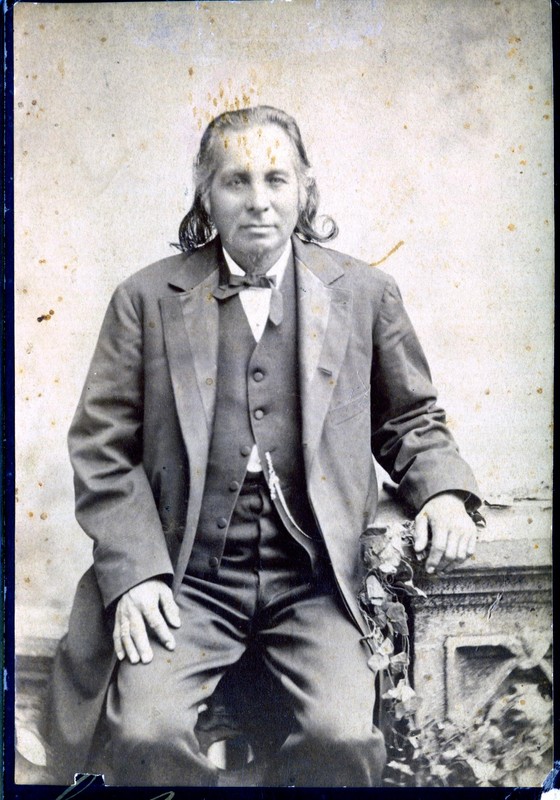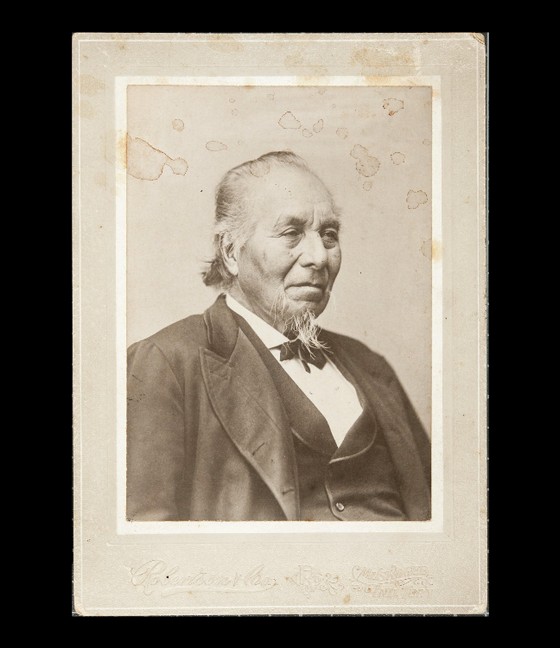Isparhecher Homestead and Grave
Introduction
Text-to-speech Audio
Images
Creek Chief Isparhecher, pictured here in Washington, D.C.

Chief Isparhecher in older age

Backstory and Context
Text-to-speech Audio
Born in the Creek Nation in Alabama in 1829, Isparhecher (also known as Ispaheche and Spahecha) Isparhecher and his family endured westward removal to Indian Territory (present day Oklahoma). The process of removal left deep scars among the Creeks, and sharp political divisions emerged between those who accepted removal and those who opposed it the last. When Isparhecher's family arrived in Indian Territory, they settled near Cussetah town (near present Okmulgee, Oklahoma). Isparhecher's father farmed, and Isparhecher followed in his father's occupational footsteps.
In 1861, the Civil War swept into Indian Territory. The Creek Nation, alongside other denizens of Indian Territory including the Cherokees, Choctaws, Chickasaws, and Seminoles, were forced to choose sides during the conflict. Old political rivalries from removal emerged. Isparhecher, who was a Lower Creek, followed many of his faction into service with the Confederate States army, enlisting in the 1st Creek Mounted Volunteers. Yet many other Upper Creeks opposed the Confederate alliance and fought for the Union. Thus the American Civil War was also a Creek civil war.
Although Isparhecher was a Lower Creek, he held traditional views of Creek culture and was of full-blood Creek ancestry. Many traditionalists (most of whom were Upper Creeks) repudiated the Confederate alliance, having relatively few slaves and little interest in white culture. Isparhecher proved to have little taste for Confederate service. He was absent without leave for most of his Confederate enlistment. When the United States military occupied Fort Gibson and northern Indian Territory in 1863, Isparhecher (along with many other Natives) defected. He enlisted in Company K, 1st Indian Home Guard (U.S.) and served honorably until war's end in 1865.
After the war, Isparhecher pursued not only farming but also politics. He served in the Creek National Council in the late 1860s and as a judge in the 1870s. During this time, Isparhecher contributed to the crafting of the Creek constitution of 1867, a controversial document which would spark trouble in years ahead.
Isparhecher had become a leader within the predominantly traditionalist Creek party. Many traditionalists rejected the 1867 constitution and sought to preserve traditional Creek ways of living. Many of these Creek traditionalists had served in the U.S. army during the Civil War (as had Isparhecher) and considered themselves the true, "loyal" faction of the Creek Nation. These political divisions boiled over in 1882 in a conflict known as the "Green Peach War" (a reference to the time of year). The traditionalists revolted, gathering under Isparhechar in rejection of the Creek constitution and government. As Creek lighthorseman (or policeman) Sam Haynes recalled, "[Isparhecher] hoped to gather enough followers to overthrow the government as it existed and go back to the type of government as it existed in 1832 before the written constitution."[4]
Violence broke out between Creek police forces (known as lighthorse) and Isparhecher's followers. A large Creek force was raised to defeat the rebels, and they clashed near at a ranch near present day Okemah, Oklahoma. Isparhecher's force was defeated, and they fled west throughout the winter. The conflict was eventually settled by the U.S. government, who managed to reconcile the dual Creek factions.
Later in life, somewhat ironically, Isparhecher was elected Principal Chief of the Creek Nation in 1895 under the very constitution of 1867 he and his followers once so fiercely opposed. He deeply opposed Federal plans of the dissolution of Creek Nation and allotment of tribal lands, which the government would ultimately accomplish after his term.
Isparhecher died in 1902 on his farm in what is now Oklmulgee County, OK. Isparhecher's farm (his second home during this life) stood at this location. It was a one story wooden frame house built around 1890. Isparhecher was buried 125 yard southwest of his homestead. Thought to have been buried with a silver saddle, his grave was looted and tombstone felled. The tombstone was repaired and a slave of stone with an epitaph added over his grave.
Sources
1. John Bartlett Meserve. "Chief Isparhecher." Chronicles of Oklahoma. Vol. 10, No. 1 (March 1932). Digitized. https://dc.library.okstate.edu/digital/collection/p17279coll4/id/28675/rec/48
2. Joseph B. Thoburn and Muriel H. Wright. Oklahoma: A History of the State and Its People. Vol. 1. New York: Lewis Historical Publishing Company, 1929. Digitized. https://texashistory.unt.edu/ark:/67531/metapth20199/
3. Kent Ruth. "Isparhecher Home and Grave." November 1975. National Register of Historic Place Inventory--Nomination Form. National Park Service, U.S. Dept. of the Interior. Digitized. https://npgallery.nps.gov/GetAsset/15841368-ca8e-4ba6-8981-ac40b58b2b48
4. Jerome M. Emmons. "Interview with Sam Haynes." May 27, 1937. Indian Pioneer Papers. University of Oklahoma Libraries. Digitized. https://digital.libraries.ou.edu/utils/getfile/collection/indianpp/id/999/filename/1891.pdf
Oklahoma Historical Society: https://gateway.okhistory.org/ark:/67531/metadc229576/m1/1/
Gilcrease Museum: https://collections.gilcrease.org/object/43263910a-b
